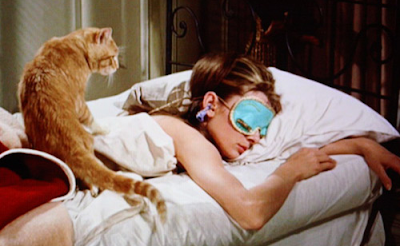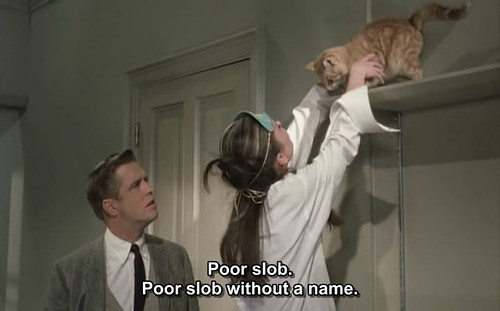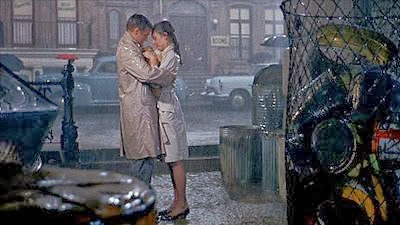
In Breakfast at Tiffany’s (1961) Audrey Hepburn performs as Holly Golightly, formerly Lula Mae Barnes. We learn that Holly has moved to New York to reinvent herself. As a consequence, she has changed her name. By destabilising her identity, she demonstrates that she takes control of her life. When Paul Varjak (George Peppard) moves into her apartment block and unexpectedly turns up at her door, he catches her unawares. Holly introduces herself to Paul by discussing her relationship with her nameless cat that she refuses to give an identity to. This is because she cannot impart a fixed identity onto another being as she does not have a fixed identity herself.
Holly announces: “Poor slob [the cat] without a name. I don’t have the right to give him one, we don’t belong to each other we just hooked up by the river one day. I don’t want to own anything until I can find a place where things go together. I’m not sure where that is, but I know what it is like.”

By using the term ‘hooked up,’ this could quite easily be referring to a chance encounter with a male acquaintance. This demonstrates why she is so blasé about the relationship she has with her cat, as she aligns it with the men in her life that are disposable to her. She creates an emotional distance with the men that pursue her in order to protect her unstable identity. Holly and the cat do not ‘belong to each other,’ as she fears emotional commitment. As well as this, Holly wants to appear to be preoccupied with ownership and financial gain to avoid having to commit to anyone. This suggests that she does not feel as though she owns the cat, not because things do not go together, but because her identity is a facade. In the same sense, she does not want to be incarcerated by marriage because she has built a reputation on being a happy-go-lucky socialite, and does not want marriage to stabilise her identity.
In the climatic ending, Holly throws Paul and the cat outside of the taxi and continues her journey alone. This is the first moment the cat has been framed in the external world. After disposing of an integral part of domestic existence, she realises that she cannot continue to live a life in which her identity is constantly shifting, so she frantically searches for “cat.” By calling him “cat” she gives him a form of identity, embracing him as a part of a new and stable self-hood. This is emphasised by the fact that she is overwrought with emotion in this sequence as she cannot find the cat. When she does finally finds him he is soaking wet but she physically embraces him, and then Paul. The film ends with a long shot of Holly and Paul in a romantic embrace with the cat between them. This shows that by embracing the cat, and thus her domestic identity, she accepts the potentiality of love, marriage and committing to another being.
